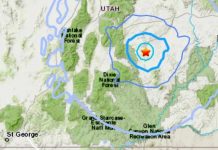June 22 (UPI) — American scientists announced Thursday the discovery of a new species of horned dinosaur which at 11,000 pounds and 22 feet long is the largest centrosaurine ever found in North America and roamed the swamps of what is now the badlands of Montana in the late Cretaceous period 78 million years ago.
The new dinosaur was identified and subsequently christened Lokiceratops rangiformis by Colorado State University affiliate faculty member Joseph Sertich and University of Utah Professor Mark Loewen due to an ostentatious set of curving blade-like horns on the rear of its “frill” and an asymmetrical horn that bear comparison with the antlers of caribou, Colorado State University said in a news release.
The find, detailed in a peer-reviewed study published in the scientific journal PeerJ, is named for Loki, a mythological human-like Norse god with horns and its Triceratops descendant and translates, approximately, to “Loki’s horned face that looks like a caribou.”
“The dinosaur now has a permanent home in Denmark, so we went with a Norse god, and in the end, doesn’t it just really look like Loki with the curving blades?” said Loewen, co-author and paleontologist at the Natural History Museum of Utah in Salt Lake City.
Speaking as a replica was put on display to the public at the museum, co-author and Smithsonian Tropical Research Institute paleontologist Sertich said: “It’s one of those stories with a happy ending, where it didn’t go to somebody’s mansion. It ended up in a museum, where it will be preserved forever so people can study it and enjoy visiting it.”
The original is on permanent display at the Museum of Evolution on the Danish island of Lolland, south of Copenhagen, Denmark, to which both men are scientific consultants.
Sertich and Loewen reconstructed the head and frill/horns array from dinner plate-sized and smaller-sized bone fragments found in 2019 in northern Montana, just south of the Canadian border
Once they had pieced the skull together they realized they had a new dinosaur species, the largest ever North American find from a group of horned dinosaurs called centrosaurines.
It has the largest frill horns ever seen on a horned dinosaur but does not have the nose horn common to most centrosaurines.
“This new dinosaur pushes the envelope on bizarre ceratopsian headgear, sporting the largest frill horns ever seen in a ceratopsian,” said Sertich.
“These skull ornaments are one of the keys to unlocking horned dinosaur diversity and demonstrate that evolutionary selection for showy displays contributed to the dizzying richness of Cretaceous ecosystems.”
However, as formidable as its appearance makes it seem Lokicertatops’ elaborate headgear had everything to do with showing off and nothing to do with predation as it was, like Triceraptops, a harmless plant eater.
Comparing dinosaur horns to feathers on birds, Sertich noted how they have evolved distinct colors and patterns to differentiate the species to which they belong from other similar bird species.
“We think that the horns on these dinosaurs were analogous to what birds are doing with displays. They’re using them either for mate selection or species recognition,” he said.
Lokiceratops was excavated from the same rock layer as four other dinosaur species suggesting all five were alive 78 million years ago in the swamps and coastal plains along the eastern shore of a then-sea down the middle of the continent, three of which were closely related but only found in that region.
“It’s unheard-of diversity to find five living together, similar to what you would see on the plains of East Africa today with different horned ungulates,” Sertich said.
The discovery of Loki is evidence these three species appeared within a relatively short period but were geographically limited to this distinct locale — a process often seen among birds on islands or otherwise isolated habitats — unlike the wide range of mammals, such as elk, now found all across the western United States.
However, these regional differences had been ironed out by the end of the Cretaceous era, leaving just two species of horned dinosaurs from Canada to Mexico which Sertich postulated could have been due to regional differences in climatic conditions being replaced with a homogenous climate.
The end of the Cretaceous period spelled the end for the horned dinosaurs, and indeed the dinosaur era itself, with the Chicxulub impactor when a 7-mile-wide asteroid slammed into the north coast of what is now Mexico’s Yucatan Peninsula at 45,000 miles-per-hour.
The study offers both the most comprehensive genealogy of horned dinosaurs and demonstrates that there was far greater diversity among the dinosaurs than previously understood.
“Lokiceratops helps us understand that we only are scratching the surface when it comes to the diversity and relationships within the family tree of horned dinosaurs,” said Loewen.





